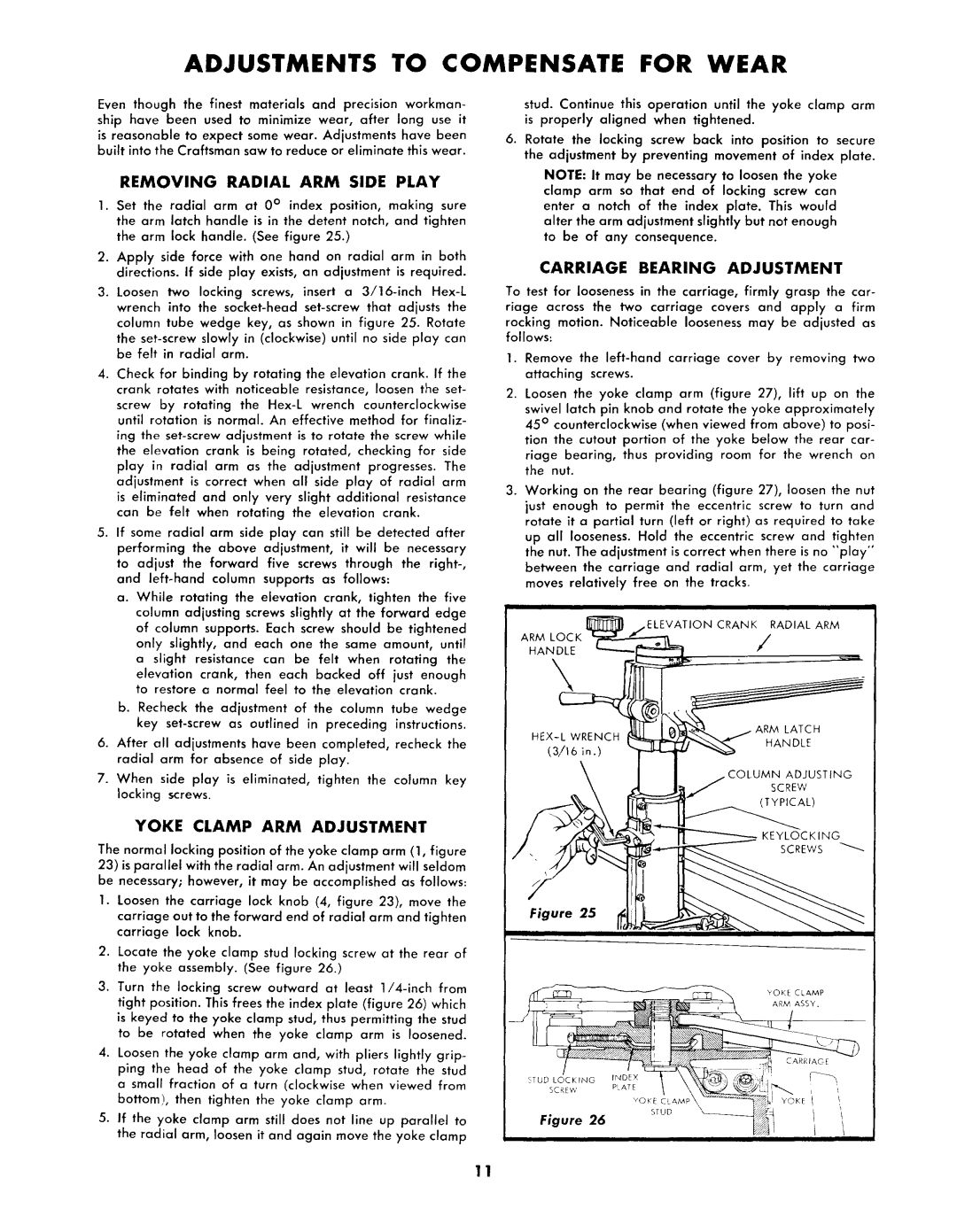
ADJUSTMENTS TO COMPENSATE FOR WEAR
Even though the finest materials and precision workman- ship have been used to minimize wear, after long use it is reasonable to expect some wear. Adjustments have been built into the Craftsman saw to reduce or eliminate this wear.
REMOVING RADIAL ARM SIDE PLAY
1.Set the radial arm at 0° index position, making sure the arm latch handle is in the detent notch, and tighten the arm lock handle. (See figure 25.)
2.Apply side force with one hand on radial arm in both directions. If side play exists, an adjustment is required.
3.Loosen two locking screws, insert a
4.Check for binding by rotating the elevation crank. If the crank rotates with noticeable resistance, loosen the set- screw by rotating the
5.If some radial arm side play can still be detected after performing the above adjustment, it will be necessary to adjust the forward five screws through the
a.While rotating the elevation crank, tighten the five column adjusting screws slightly at the forward edge of column supports. Each screw should be tightened only slightly, and each one the same amount, until a slight resistance can be felt when rotating the elevation crank, then each backed off just enough to restore a normal feel to the elevation crank.
b. Recheck the adjustment of the column tube wedge key
6.After all adjustments have been completed, recheck the radial arm for absence of side play.
7.When side play is eliminated, tighten the column key locking screws.
stud. Continue this operation until the yoke clamp arm is properly aligned when tightened.
6.Rotate the lacking screw back into position to secure the adjustment by preventing movement of index plate.
NOTE: It may be necessary to loosen the yoke clamp arm so that end of locking screw can enter a notch of the index plate. This would alter the arm adjustment slightly but not enough to be of any consequence.
CARRIAGE BEARING ADJUSTMENT
To test for looseness in the carriage, firmly grasp the car- riage across the two carriage covers and apply a firm
rocking motion. Noticeable looseness may be adjusted as follows:
1.Remove the
attaching screws.
2.Loosen the yoke clamp arm (figure 27), lift up on the swivel latch pin knob and rotate the yoke approximately
45 ° counterclockwise (when viewed from above) to posi- tion the cutout portion of the yoke below the rear car-
riage bearing, thus providing room for the wrench on the nut.
3.Working on the rear bearing (figure 27), loosen the nut just enough to permit the eccentric screw to turn and rotate it a partial turn (left or right) as required to take up all looseness. Hold the eccentric screw and tighten the nut. The adjustment is correct when there is no "'play'" between the carriage and radial arm, yet the carriage moves relatively free on the tracks.
YOKE CLAMP ARM ADJUSTMENT
The normal locking position of the yoke clamp arm (1, figure
23)is parallel with the radial arm. An adjustment will seldom be necessary; however, it may be accomplished as follows:
1.Loosen the carriage lock knob (4, figure 23), move the
carriage out to the forward end of radial arm and tighten carriage lock knob.
2.Locate the yoke clamp stud locking screw at the rear of the yoke assembly. (See figure 26.)
3.Turn the locking screw outward at least
tight position. This frees the index plate (figure 26/which is keyed to the yoke clamp stud, thus permitting the stud to be rotated when the yoke clamp arm is loosened.
4.Loosen the yoke clamp arm and, with pliers lightly grip- ping the head of the yoke clamp stud, rotate the stud a small fraction of a turn (clockwise when viewed from
bottom!, then tighten the yoke clamp arm.
5.If the yoke clamp arm still does not line up parallel to the radial arm, loosen it and again move the yoke clamp
ARM ASS¥.
11
